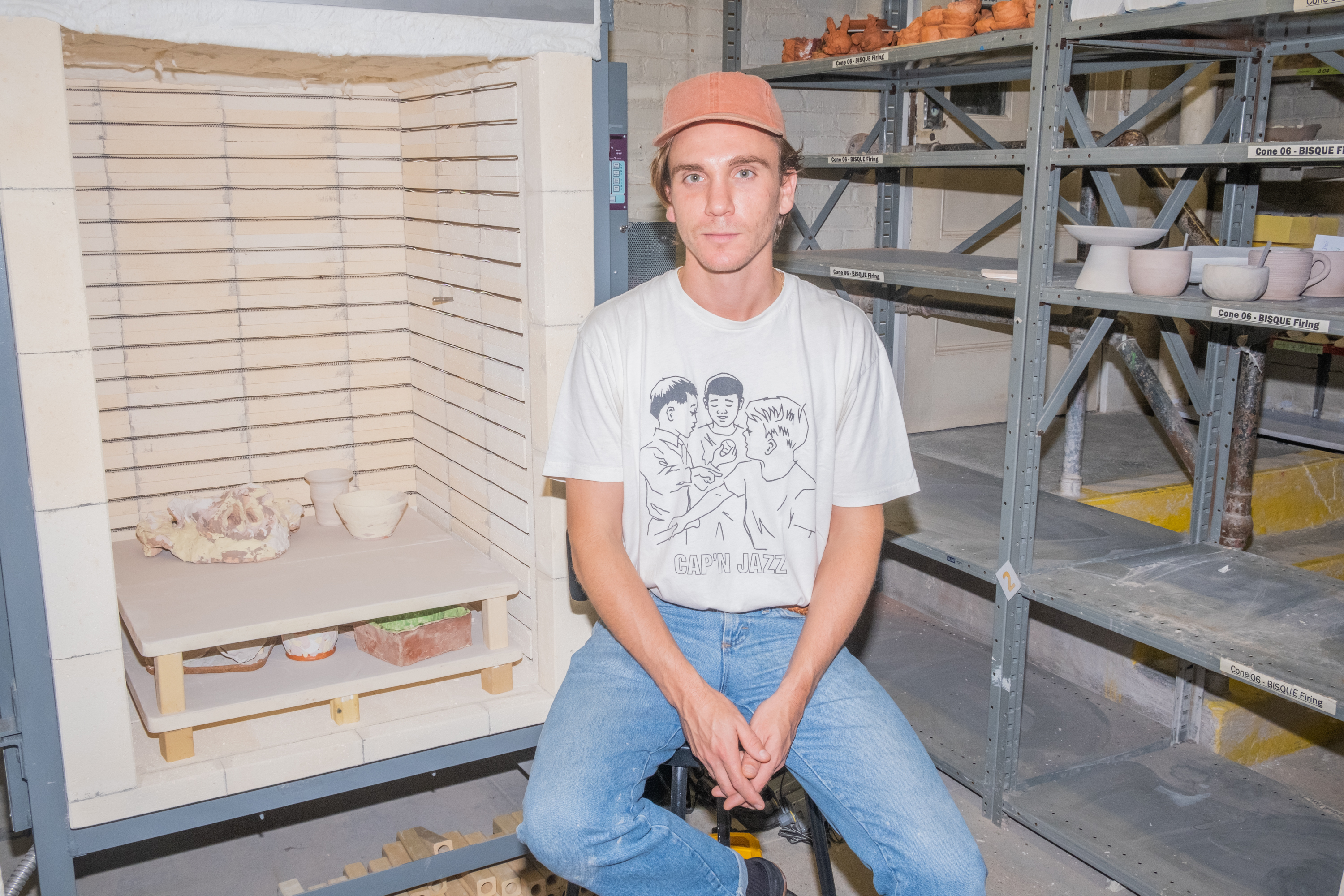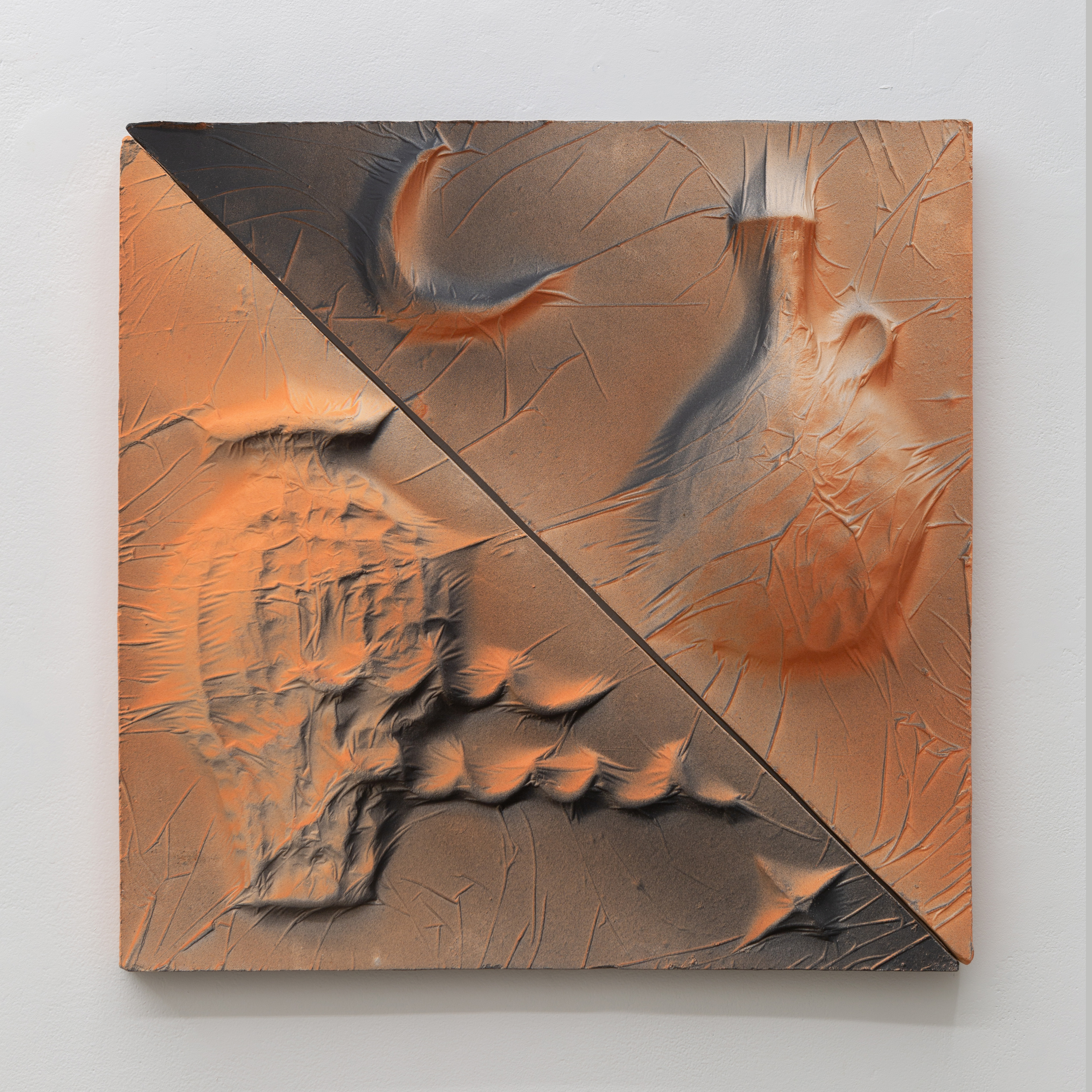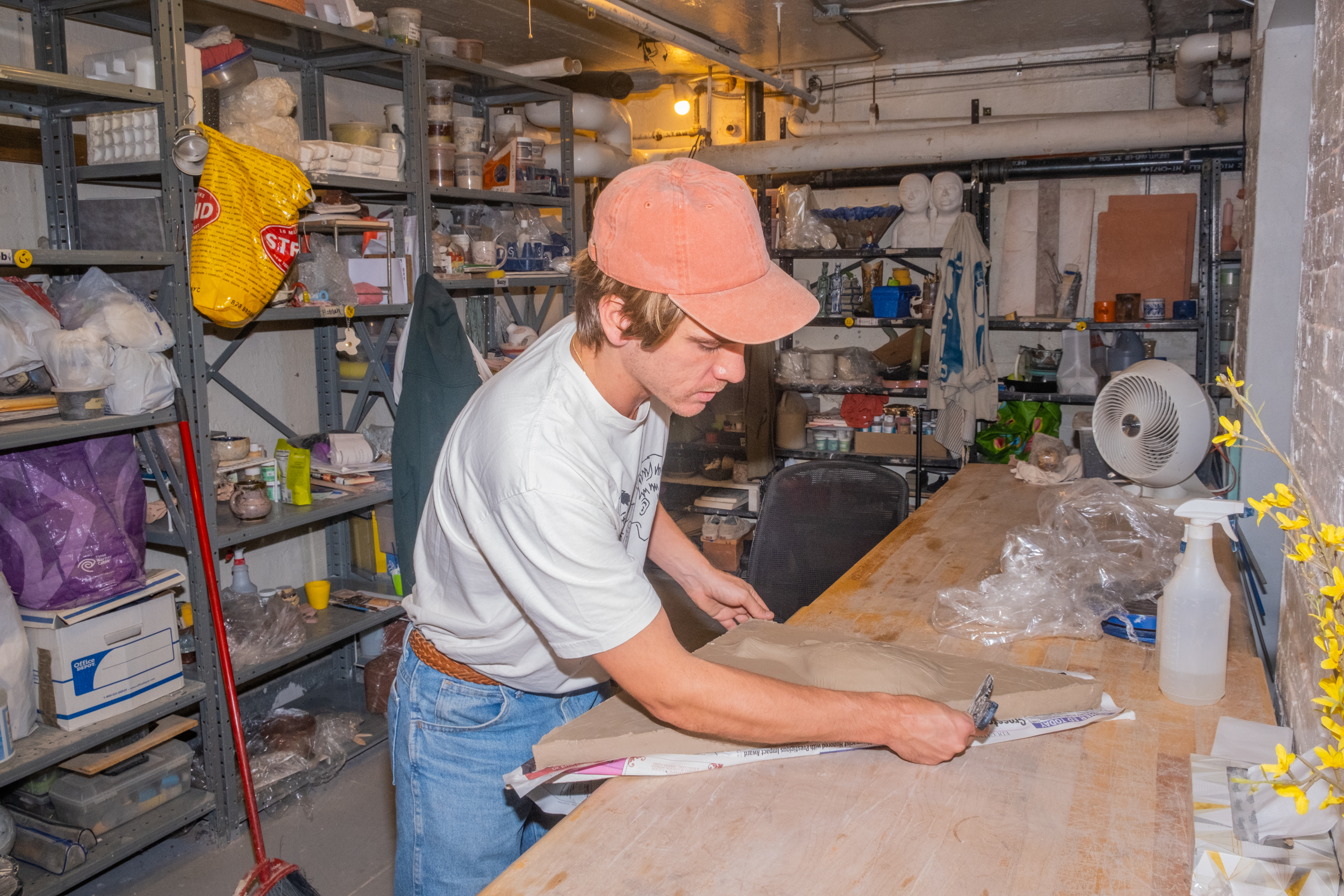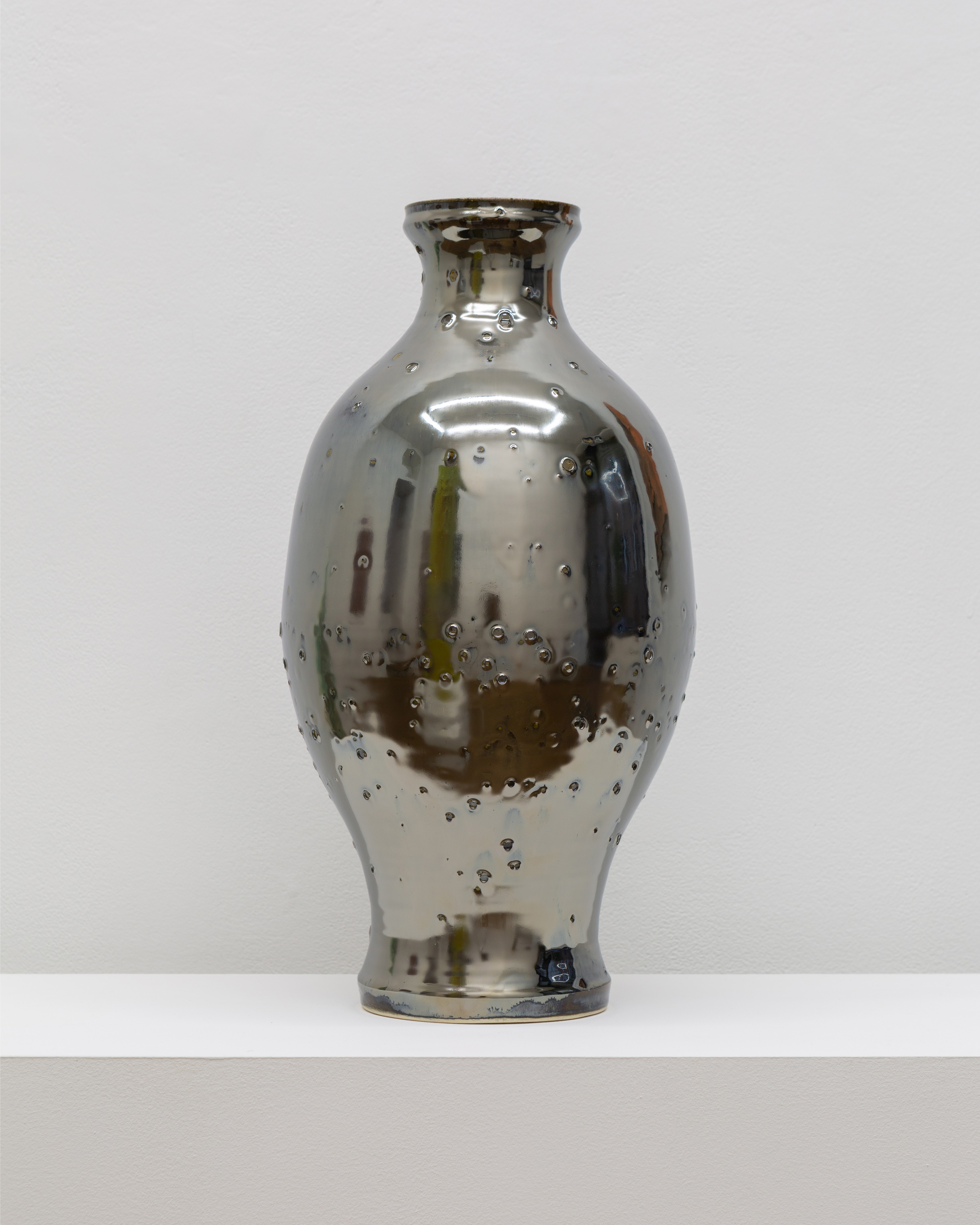In anticipation of his second solo show with New Collectors, Ryan Rennie sat down with Curator and Writer, Daphne Moses at Greenwich House Pottery to discuss his artistic legacy, the importance of practicing the fundamentals, and defining art by intention.

Daphne: Hello! Thank you so much for taking time to meet with me at Greenwich House Pottery. I know you’ve been teaching and making here for a while, so I thought I’d start with the basics: what got you into ceramics?
Ryan: I come from a family of artists. My grandfather, brother, and I all attended the Maryland Institute College of Art. My brother is a photographer and my mother is a jewelry designer. I grew up with a dark room in the house and a pretty extensive jewelry fabrication area that shifted from room to room. Also, my grandfather was a photographer and my other grandfather was a silversmith. However, my elementary and high school art teacher inspired my ceramic practice. I took my first ceramics class my sophomore year and fell in love. I knew I was good with my hands, so I pretty much decided in high school I would be pursuing ceramics.
Daphne: What was the early progress like from that initial peak into a serious pursuit of a ceramic practice?
Ryan: My junior year of high school I dual enrolled at the local community college to take night classes in ceramics. During the day at school, I’d have one or two hours of ceramics and then once or twice a week, I’d go to the community college. I chose to attend MICA for undergrad for ceramics and shortly after, went right into graduate school at Alfred University. I moved to New York City in 2017 after completing my master's program. I started by making dinnerware for Jono Pandolfi, who designs for some of the best restaurants in the world and later began fabricating work for other artists. Eventually, I began substitute teaching at MICA for one term, then Art Shack, BKLYN CLAY, and eventually, here [Greenwich House Pottery.] I also got a studio in Ridgewood, Queens. During the pandemic, I moved to Asheville and did a short residency before moving back to New York.
Daphne: On the subject of teaching, how does that factor into your individual craft? Or does it exist on a totally other plane?
Ryan: Absolutely teaching has an influence. I think I gain a lot of insight in helping people understand the basics around pottery making — though most of my work is sculptural or on the wall, I was trained in traditional pottery. There’s a history of pot making as this intellectual practice to explore the poetics and philosophies behind craft, making, labor, etc. Through teaching, I am able to remain in touch with those ideas. Although all sorts of things are made at Greenwich House Pottery (sculpture, architectural works, tiles, etc.) we often start with the vessel. In taking this material, this mush from the earth, you learn how to give it volume. A vessel is a really good way to explore that. Similarly, the general language of pottery is something my work will always center around to some extent, even when I am not directly making pots. I’m a sculptor who thinks about pottery non-stop.
Daphne: It’s fascinating how revisiting the fundamentals of your practice over and over again can ground your work. A bit of a deviation, but I’m really interested in your use of color – specifically the color orange. It’s not the flat terracotta I would expect in pottery. It’s almost luminous. There's something almost metallic about it. How are you utilizing color and value?
Ryan: The orange you see is the clay itself, a similar terracotta to what may be used to make a terracotta roof or flower pot. I just returned from Spain and I was in Ecuador earlier this year. I am always fascinated by the terracotta everywhere in architecture and pottery. I’m also inspired by much of the ornamentation I see on historic buildings throughout New York City, often made directly (or prototyped) with clay and plaster. Currently, I am drawn to tile, pottery, and architecture that uses clay from throughout history. For me, the terracotta fits nicely into that. I don’t want it to look like this flat, dry terracotta – it looks different because I spray different glazes on top to make it pop.

Daphne: I can see how that use of the (terracotta) color is also grounded in the fundamentals of pottery and the history of pot-making. You’ve mentioned that much of your work is informed by history; it appears to show a dichotomy between artifacts and commercial icons in many of your pieces. I’m curious how that developed, how you juxtaposed those things, but also what your philosophy is?
Ryan: I just love to consume knowledge pertaining to ceramic history. I’m also really interested in not just written history but the oral history and mythology that develops around artists, especially in a place like this [Greenwich Pottery House]. With over a hundred years of history, we’ve had different artists from “The Canon” here. You hear stories of what that was like. The same can be said for my graduate school. Alfred University has an even longer history of ceramics in which this oral, mythological sense of the place and its people gets passed around. The myth of makers is just as important as any facts for me. At the same time, there is so much serious thinking and dogma around craft ideology and processes. I approach it with the utmost respect and as a teacher, I have to be the carrier of that knowledge.
I also want to poke fun at it or disarm some of the reverence at times. I am interested in things like pastiche or parody or even bad copies of things. In graduate school, I collected a lot of objects from the dollar store or Walmart or thrift stores. The things that I would gravitate towards would often be referencing some ancient history or some form of prehistory. They often had to do with ceramics, vessels, or just plastic stuff that was made to look old for interior decoration of lawn decor or ornaments. In a way, these objects made an attempt to relocate you to a different time period or place. I think sometimes craft objects make the same attempt, though with an approach poised as something more respectable. I often wonder if it is. How do I honor both the fake and the original? Or, is it even a fake, or just another thing entirely? I ask myself this because I think they are both valid, poetic, have meaning, and an impact on the world. What we change is the assigned value which brings up other issues pertaining to an object’s worth.
I’m glad you picked up on some of that thinking from looking at the work. A lot of my work appears to be draped in fabric or depicts objects lying beneath a veil. I always go back to Giuseppe Sanmartino’s Veiled Christ. Though in the case of my work, it could land somewhere between vacuum sealed for production or sale, while simultaneously feeling reverently veiled beneath fabric. I like to ride that line between reverence and comedic tragedy, parody.
Daphne: That philosophy is really unique in your craft. As a writer and comedic artist, I find that you really do capture a kind of parody that doesn’t hit you over the head. The idea that something is easily accessible is tied to the idea that such a thing is inherently less valuable. It’s both funny and compelling to discuss value when making an original of a reproduction, and discussing the relationship between the two. It makes for a different type of time capsule, I suppose.
Ryan: Yes, there is a lot to explore and I have been thinking a lot about time capsules and I want to make one soon. I think as artists we really want to preserve something, leave a mark, and not be forgotten.

Daphne: Yeah, and I think going back to history, your return to the fundamentals of pottery is similar to the references to history. I feel as though some of your work evokes a certain feeling of memory or objects of age. I suppose I am interested in how you feel as though you are exploring history in a contemporary space. Let me rephrase, in regards to the time capsule, you’re creating something new from something old–what do you want to say?
Ryan: Yeah, I think that is something a bit tragic about art history, how it is constantly self-referential. Every object comes after the one before it, in either image or art making. It’s a trope, how I aim to make contemporary art that references artifacts. I think there are lots of different formulas for art making, just in the way there are formulas for making certain types of movies. With a horror film, you have to fulfill certain aspects before you can consider it a horror film. I then have to think to myself, what needs to fall into place in order to consider myself a contemporary sculptor? What formula am I going to use? Is it legit? Am I copying someone else’s formula? Is it all just a game? I get caught up in that thinking. What does it mean to make self-referential art when we’ve already established that art history itself is self-referential? It then becomes a personal study that mirrors a larger one, I guess. I am trying to be aware of that without getting too caught up in it. In the end, I am actually very process oriented. When I lean too much into the thinking, the making gets worse. I really do try to follow my hands and I normally try to start with a material question and think– what if I do this? What will that look like? What happens if I make a mold of this thing? It is important for me to have more questions than answers. I do really get bogged down by the theory and at that point, I really need to just trust my hands. Sometimes that means sitting at the potter's wheel, or just making a mold of something I find interesting. I guess I am constantly just trying to find a balance between the thinking and the making. When one gets overdone, I have to transition back to the other one.
Daphne: That’s definitely a balance of mind and matter or even philosophy and physicality. I have been very interested in your recent works which I’ve seen online and through social media. I am curious as to what you’re playing with right now? I say play in this context because it feels more suitable than experimenting.
Ryan: Yeah, I am playing with objects in landscapes. Things like a bowl floating in space, but under a veil. I am also working with vessels right now and making functional pots because I feel stuck in making some of the wall works. I am also making stools, pottery, some larger free standing works. There are a lot of things going on in the studio and I don't always know how they will fit together or if they’ll live in the same world. Function seems to weave in and out of it all.

Daphne: I guess that is one of the ongoing questions: how do you interact with function? Does that have some impact on how you’re thinking about your works aesthetically or does it ever feel like a limitation or template?
Ryan: That’s a good question. It’s hard because I don’t make a ton of functional stuff but I think about it constantly. In studying ceramics or craft oriented practices, there is always this tired debate of craft vs. art? You hear it on the first and last day of art school if you study ceramics. The conclusion I’ve come to is that it is all connected, but I think it comes down to what the maker intends. There are potters who call themselves artists and then there are potters who do not want to be lumped in with the sculptors or other artists. For me, I leave it up to the maker as to what they want to call themself, but I personally view all making processes as art-oriented and I don’t like to assign more or less value to either. I am just fascinated by making. When I am walking down a New York City street and I see someone laying down concrete, I think ‘wow that guy is doing that like a fucking artist’ because I know that takes skill and craft as well as a lot of thought going into our built environment. But many of the people who construct our world probably wouldn’t consider themselves artists. For me, I try not to differentiate but try and absorb it all, functional or not, art or not. As a studio manager, I have to do a little bit of everything. I'm doing electrical work, plumbing, masonry, anything the facilities might need. I'm working with a team of technicians to process the materials (mostly clays and glazes) and oversee the firing of artwork for over four hundred students. Then there is the teaching component, too. It's all an extension of my art practice and the only way to balance it all is to just try to live artfully. If I can implement this thinking into all that I do, that it is indeed all connected, the art making comes more fluidly. If I let up on this, the object making becomes more difficult. I try not to concern myself too much with timely expectations of being in the studio. I think a lot of artists have this internal guilt or feeling that they need to be making whenever they can, but if you live artfully you never really leave the studio. I guess I just mean I have to live an intentional and balanced life if I want the art making to happen in an authentic way.
Daphne: Living artfully, I think that is a sustainable way of living without driving yourself into madness. Would you say art making has to do more with intention? Like a mason may not look at themselves and think ‘I am an artist.’ Do you think artwork is identified by reception or intention?
Ryan: I think it is done with intention for sure. If the person who laid the sidewalk wanted to call it art, I’d have to believe them. It is just as impactful to me whether it is art or not. I can find poetry in it whether or not they can. Living artfully feels like living with intention. As an object maker, I notice that everything around me is built and designed. Nothing around us wasn’t built, designed, or fabricated. Whether made by human hands or a robot made by human hands. It is one huge force of a human’s capacity to build or make.
Daphne: I think that is a very cool way of interacting with object making. Now I’m going to have to watch people lay down pavement.
Ryan: Yeah, or, when you see someone putting up drywall, just try to notice what they’re doing. Noticing how they’re doing it in a very cool way.
Daphne: Just to wrap it up, just for kicks, what are you into right now?
Ryan: I really love backpacking and hiking. I am working towards the “New Hampshire 48”, which is hiking the 48 tallest mountains in the state. I am nearly half way there!
Ryan Rennie's exhibition, Pottery/Star, is on view at New Collectors until October 22, 2023
